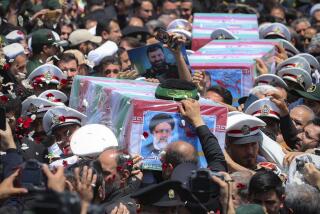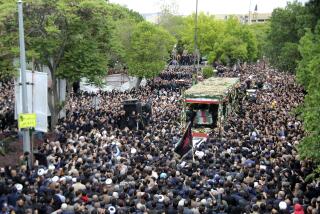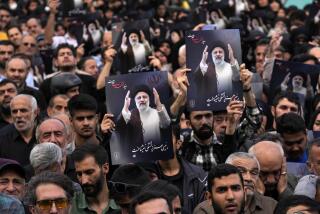Crisis Reflects a New Iran
- Share via
Rescue efforts after great natural disasters can be impeded by governments too proud or fearful of outsiders to ask for even desperately needed help. In 1990, Iran’s mullahs bridled at international offers of aid after an earthquake hit the nation’s northwest and killed as many as 50,000 people. Today, under moderate President Mohammad Khatami’s leadership, Tehran has sped assistance to the ancient city of Bam, where tens of thousands reportedly perished in and after an earthquake Friday.
Khatami quickly appealed for help, acknowledging that the first 48 hours were the most critical. Iran welcomed U.S. relief planes; its major vestige of the past came in ruling out help from Israel. Extraordinary local and international efforts averted a potentially worse tragedy, though the dangers of disease and exposure are far from over and distraught residents protest bitterly that Iran’s government has done too little.
Iranian volunteers have been burying the dead in mass graves to forestall the spread of diseases such as tetanus, diphtheria and dysentery. In a race against time, rescue workers have abandoned the Islamic custom of washing corpses before burial. Grieving families, understanding the peril, seem mostly to have agreed without complaint.
Iranians have been donating blood, blankets and clothes, supplies that will get to the quake zone much faster than international donations of goods. With large numbers homeless, the danger from cold weather is acute. Aid has poured in swiftly from outside as well, because Iran wisely waived visa considerations. Japan, Germany and the United States, among other nations, are supplying assistance. The Pentagon is delivering more than 150,000 pounds of medical supplies from Kuwait, largely being distributed by the United Nations.
Iranian volunteers have arrived in Bam from around the country, some clawing through the rubble barehanded. Now, rescue workers from countries such as Germany are preparing to withdraw; few people trapped in rubble live for more than 72 hours. German rescuers said the stench of death over the city was so powerful their dogs could no longer properly sniff for survivors under ruins.
Iran’s conservative supreme leader, Ayatollah Ali Khamenei, has vowed to rebuild the historic city. But rebuild what? The ancient, beautiful mud and brick buildings that crumbled to dust and asphyxiated thousands? Khamenei’s statement is an echo of an earlier Iran, one that made delusional promises to paper over real-life suffering.
The true leaders in this great disaster are those, including Khatami and local leaders in Bam, who seek to carry out basic tasks quickly and effectively -- to bury the dead, stop looting, forestall epidemics and house and feed the living. Their welcome of international relief organizations is another sign of change in Iran. The victims and survivors, not political hatreds, are coming first.
More to Read
Sign up for Essential California
The most important California stories and recommendations in your inbox every morning.
You may occasionally receive promotional content from the Los Angeles Times.









